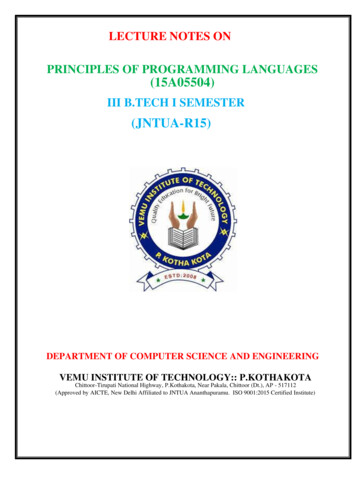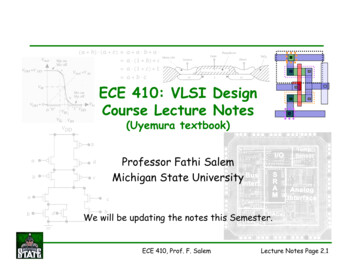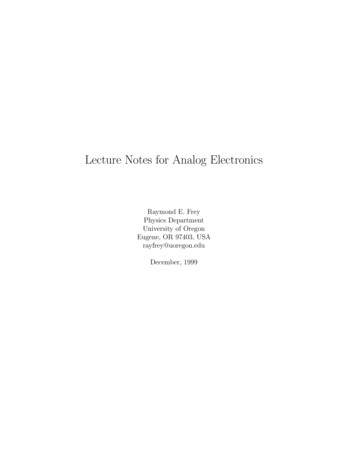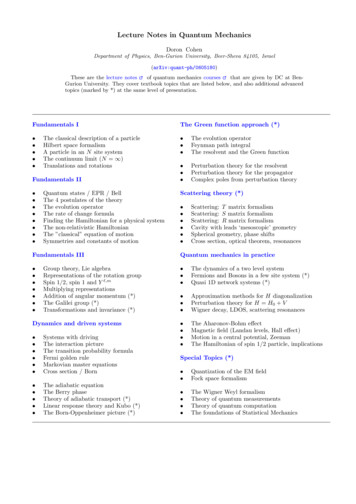
Transcription
LECTURE NOTES ONPRINCIPLES OF PROGRAMMING LANGUAGES(15A05504)III B.TECH I SEMESTER(JNTUA-R15)DEPARTMENT OF COMPUTER SCIENCE AND ENGINEERINGVEMU INSTITUTE OF TECHNOLOGY:: P.KOTHAKOTAChittoor-Tirupati National Highway, P.Kothakota, Near Pakala, Chittoor (Dt.), AP - 517112(Approved by AICTE, New Delhi Affiliated to JNTUA Ananthapuramu. ISO 9001:2015 Certified Institute)
JAWAHARLAL NEHRU TECHNOLOGICAL UNIVERSITY ANANTAPURB. Tech III-I Sem. (CSE)LTPC3 10 315A05504 PRINCIPLES OF PROGRAMMING LANGUAGESUnit andSoftwareDevelopmentEnvironments, Language and Software Design Models, Language andComputerArchitecture, Programming Language Qualities, A brief Historical Perspective.Syntax and Semantics: Language Definition, Language Processing, Variables,Routines,Aliasing and Overloading, Run-time Structure.Unit II:Structuring the data: Built-in types and primitive types, Data aggregates andtypeconstructors, User-defined types and abstract data types, Type Systems, ThetypeStructure of representative languages, Implementation ModelsUnit III:Structuring the Computation: Expressions and Statements, Conditional ExecutionandIteration, Routines, Exceptions, Pattern Matching, Nondeterminism andBacktracking, Eventdriven computations, Concurrent ComputationsStructuring the Program: Software Design Methods, Concepts in Support ofModularity,Language Features for Programming in the Large, Generic UnitsUnit IV:Object-Oriented Languages: Concepts of Object-oriented Programming, Inheritancesandthe type system, Object-oriented features in programming languagesUnit imperativelanguages,Mathematical and programming functions, Principles of FunctionalProgramming,Representative Functional Languages, Functional Programming in C Logic and Rule-based Languages: ―What‖ versus ―how‖: Specificationversusimplementation, Principles of Logic Programming, PROLOG, FunctionalProgrammingversus Logic Programming, Rule-based LanguagesTextbook:1) ―Programming Language Concepts‖, Carlo Ghezzi, Mehdi Jazayeri, WILEYPublications. Third Edition, 2014Reference Textbooks:1. Concepts of Programming Languages, Tenth Edition, Robert W. Sebesta,PearsonEducation.2. Programming Languages Principles and Paradigms, Second Edition, Allen B.Tucker,Robert E. Noonan, McGraw Hill Education.3. Introduction to Programming Languages, Aravind Kumar Bansal, CRC Press.
UNIT 1INTRODUCTIONSoftware Development Process:The software is said to have a life cycle com-posed of several phases. Each of thesephases results in the development of either a part of the system or something associated withthe system, such as a fragment of specification, a test plan or a users manual. In thetraditional waterfall model of the software life cycle.A sample software development process based on the waterfall model may becomprised of the following phases:Requirement analysis and specification: The purpose of this phase is to identifyanddocument the exact requirements for the system.These requirements are developed jointlyby users and software developers. The result of this phase is a requirements document statingwhat the system should do, along with users' manuals, feasibility and cost studies,performance requirements, and so on. The requirements document does not specify how thesystem is going to meet its requirements.Software design and specification: Starting with the requirements document,softwaredesigners design the software system. The result of this phase is a system designspecification document identifying all of the modules comprising the system and theirinterfaces.Implementation (coding): The system is implemented to meet the design specified intheprevious phase. The design specification, in this case, states the “ what” ; the goal of theimplementation step is to choose how, among the many possible ways, the system shall becoded to meet the design specification. The result is a fully implemented and documentedsystem.Verification and validation: This phase assesses the quality of the implementedsystem,which is then delivered to the user. Note that this phase should not be concentrated atthe end of the implementation step, but should occur in every phase of software developmentto check that intermediate deliverables of the process satisfy their objectives. The checks areaccomplished by answering the following two questions: “Are we building the productright?” “Are we building the right product?” Two specific kinds of assessment performedduring implementation are module testing and integration testing.Maintenance: Following delivery of the system, changes to the system maybecomenecessary either because of detected malfunctions, or a desire to add new capabilitiesor to improve old ones, or changes that occurred in operational environment.Programming languages are used only in some phases of the development process.They are obviously used in the implementation phase, when algorithms and data structuresare defined and coded for the modules that form the entire application. Moreover, modernhigher-level languages are also used in the design phase, to describe precisely thedecomposition of the entire application into modules, and the relationships among modules,before any detailed implementation takes place.Language and Software Development Environments:
A software developmentenvironment we mean an integrated set of tools andtechniques that aids in thedevelopment of software. The environment is used in all phases ofsoftware development: requirements, design, implementation, verification and validation, andmaintenance.The work in any of the phases of software development may be supported bycomputer-aided tools. The phase currently supported best is the coding phase, with such toolsas text editors, compilers, linkers, and libraries. These tools have evolved gradually, as theneed for automation has been recognized. Nowadays, one can normally use an interactiveeditor to create a program and the file system to store it for future use. When needed, severalpreviously created and (possibly) compiled programs may be linked to produce an executableprogram. A debugger is commonly used to locate faults in a program and eliminate them.These computer-aided program development tools have increased programming productivityby reducing the chances of errors.Language and Software Design Models:The relationship between software design methods and programming languages is animportant one. To understand the relationship between a programming language and a designmethod, it is important to realize that programming languages may enforce a certainprogramming style, often called a programming paradigm.Here we review the most prominent programming language paradigms, with specialemphasis on the unit of modularization promoted by the paradigm.Procedural programming:This is the conventional programming style,where programs aredecomposed into computation steps that perform complex operations. Procedures andfunctions (collectively called routines) are used as modularization units to define suchcomputation steps.Functional programming:The functional style of programming is rooted inthe theory ofmathematical functions. It emphasizes the use of expressions and functions. The functions arethe primary building blocks of the program; they may be passed freely as parameters and maybe constructed and returned as result parameters of other functions.Abstract data type programming: Abstract-data type (ADT) programmingrecognizesabstract data types as the unit of program modularity. CLU was the first language designedspecifically to support this style of programming.Module-based programming: Rather than emphasizing abstract-data types,module-basedprogramming emphasizes modularization units that are groupings of entities such as variables,procedures, functions, types, etc. A program is composed of a set of such modules. Modula-2and Ada support this style of programming.Object-oriented programming: The object-oriented programming style emphasizes thedefinition of classes of objects. Instances of classes are created by the program as neededduring program execution. This style is based on the definition of hierarchies of classes andrun-time selection of units to execute. Smalltalk and Eiffel are representative languages ofthis class. C and Ada 95 also support the paradigm.
Generic programming: This style emphasize the definition of generic modules that may beinstantiated, either at compile-time or runtime, to create the entities data structures, functions,and procedures needed to form the program. This approach to programming encourages thedevelopment of high-level, generic, abstractions as units of modularity. It can exist jointlywith object-oriented programming, as in Eiffel, with functional programming, as in ML. Italso exists in languages that provide more than one paradigm, like Ada and C .Declarative programming: This style emphasizes the declarative description of a problem,rather than the decomposition of the problem into an algorithmic implementation. As such,programs are close to a specification. Logic languages, like PROLOG, and rule-basedlanguages, like OPS5 and KEE, are representative of this class of languages.Language and Computer Architecture:Languages have been constrained by the ideas of Von Neumann, because mostcurrent computers are similar to the original Von Neumann architectureFigure 1.A Von Neumann computer architectureThe Von Neumann architecture, sketched in Figure 1, is based on the idea of amemory that contains data and instructions, a CPU, and an I/O unit. The CPU is responsiblefor taking instructions out of memory, one at a time. Machine instructions are very low-level.They require the data to be taken out of memory, manipulated via arithmetic or logicoperations in the CPU, and the results copied back to some memory cells. Thus, as aninstruction is executed, the state of the machine changes.Conventional programming languages can be viewed as abstractions of an underlyingVon Neumann architecture. For this reason, they are called Von Neumann languages. Anabstraction of a phenomenon is a model which ignores irrelevant details and highlights therelevant aspects. Conventional languages based on the Von Neumann computation model areoften called imperative languages. Other common terms are state-based languages, orstatement-based languages, or simply Von Neumann languages.The historical developments of imperative languages have gone through increasinglyhigher levels of abstractions. In the early times of computing,.Many kinds of abstractions were later invented by language designers, such asprocedures and functions, data types, exception handlers, classes, concurrency features, etc.As suggested by Figure 2, language developers tried to make the level of programminglanguages higher, to make languages easier to use by humans, but still based the concepts ofthe language on those of the underlying Von Neumann architecture.
Figure 2.Requirements and constraints on a languageOther kinds of parallel languages exist supporting parallelism at a much finergranularity, which do not fall under the classification shown in Figure 3.Figure 3.Hierarchy of paradigmsProgramming Language Qualities:A programming language is a tool for the development of software. Thus, ultimately,the quality of the language must be related to the quality of the software.Software must be reliable. Users should be able to rely on the software, i.e.,the chance offailures due to faults in the program should be low.The reliability goal is promoted by several programming language qualities.- Writability. It refers to the possibility of expressing a program in a way thatisnatural for the problem. The programmer should not be distracted by details andtricks of the language from the more important activity of problem solving. Forexample, an assembly language programmer is often distracted by the addressingmechanisms needed to access certain data, such as the positioning of indexregisters, and so on. The easier it is to concentrate on the problem-solvingactivity, the less error-prone is program writing and the higher is productivity.- Readability. It should be possible to follow the logic of the program andtodiscover the presence of errors by examining the program.- Simplicity. A simple language is easy to master and allows algorithms tobeexpressed easily, in a way that makes the programmer self-confident.Simplicity can obviously conflict with power of the language. For example,Pascal is simpler, but less powerful than
--Safety. The language should not provide features that make it possible towriteharmful programs.For example, a language that does not provide goto statementsnor pointer variables eliminates two well-known sources of danger in a program.Such features may cause subtle errors that are difficult to track during programdevelopment,Robustness. The language supports robustness whenever it provides theability todeal with undesired events (arithmetic overflows, invalid input, and so on). Thatis, such events can be trapped and a suitable response can be programmed torespond to their occurrence.Software must be maintainable. Existing software must be modified to meet newrequirements. Also, because it is almost impossible to get the real requirements right in thefirst place, for such complex systems one can only hope to gradually evolve a system into thedesired one.Two main features that languages can provide to support modification are factoringand locality.- Factoring. This means that the language should allow programmers to fac-torrelated features into one single point. As a very simple example, if an identicaloperation is repeated in several points of the program, it should be possible tofactor it in a routine and replace it by a routine call.- Locality. This means that the effect of a language feature is restricted to asmall,local portion of the entire program. Otherwise, if it extends to most of theprogram, the task of making the change can be exceedingly complex. Forexample, in abstract data type program-ming, the change to a data structuredefined inside a class is guaranteed not affect the rest of the program as long asthe opera-tions that manipulate the data structure are invoked in the sameSoftware must execute efficiently. This goal affects both the programming language (featuresthat can be efficiently implemented on present-day architectures) and the choice ofalgorithms to be used.The need for efficiency has guided language design from the beginning. Manylanguages have had efficiency as a main design goal, either implicitly or explicitly. Forexample, FORTRAN originally was designed for a specific machine (the IBM 704). Many ofFORTRAN's restrictions, such as the number of array dimensions or the form of expressionsused as array indices, were based directly on what could be implemented efficiently on theIBM 704.Efficiency is often a combined quality of both the language and its implementation.The language adversely affects efficiency if it disallows certain optimizations to be appliedby the compiler. The implementation adversely affects efficiency if it does not take allopportunities into account in order to save space and improve speed.A brief Historical Perspective:Table 1: Genealogy of selected programming languagesLanguageYearOriginatorFORTRAN1954-57J. putingReferenceGlossary
ALGOL 4FORTRANNumericcomputingNaur 1963CommitteeBusinessdataprocessingGlossaryK. IversonArray processingIverson 19621956-62 J. McCarthySymboliccomputingGlossary1962-66 R. GriswoldString processingGriswold et al.PL/I1963-64CommitteeFORTRANALGOL 60COBOLGeneralpurposeANSI 1976SIMULA 671967O.-J.DahlALGOL 60SimulationBirtwistle et al.1973ALGOL 60GeneralpurposevanWijngaardenet al.1976Lindsay andvanderMeulen 1977ALGOL clidGypsyModula-2AdaSmalltalkC 1963-68CommitteeEducationalandgen. purpose1972 A. ColmerauerArtificialintelligence1974D. RitchieALGOL 68 Systemsprogramming1974Committee SIMULA 67 Systems programming1974J. SchwartzVery highlevel lang.P. ramming1974-77 B. LiskovSIMULA ams1977D. GoodPascalVerifiableprograms1977N. WirthPascalSystems programmingPascalGeneralpurpose1979J. IchbiahSIMULA 67EmbeddedsystemsSIMULA 671971-80A. KayPersonalcomputingLISPB. StrousC1984GeneralpurposetrupSIMULA 671971N. WirthALGOL 60GlossaryGlossaryGlossaryGeschke et al.1977Schwartz et al.1986Brinch Hansen1977Abelson and Sussman1985Liskov et al. 1981Lampson et al.1977Ambler et al.1977GlossaryGlossaryGlossaryGlossarySyntax and SemanticsLanguage Definition:A language definition should enable a person or a computer program to determine (1)whether a purported program is in fact valid, and (2) if the program is valid, what its meaningor effect is. In general, two aspects of a language-program-ming or natural language-must bedefined: syntax and semantics.Syntax:Syntax is described by a set of rules that define the form of a language: they definehow sentences may be formed as sequences of basic constituents called words. Using these
rules we can tell whether a sentence is legal or not. The syntax does not tell us anything aboutthe content (or meaning) of the sentence– the semantic rules tell us that. As an example, Ckeywords (such as while, do, if, else,.), identifiers, numbers, operators, . are words of thelanguage. The C syntax tells us how to combine such words to construct well-formedstatements and programsThe syntax of a language is defined by two sets of rules: lexical rules and syntacticrules. Lexical rules specify the set of characters that constitute the alphabet of the languageand the way such characters can be combined to form valid words. For example, Pascalconsiders lowercase and uppercase characters to be iden-tical, but C and Ada consider themto be distinct. Thus, according to the lexi-cal rules, “ Memory” and “ memory” refer to thesame variable in Pascal, but to distinct variables in C and Ada. The lexical rules also tell usthat (or ) is a valid operator in Pascal but not in C, where the same operator is representedby ! . Ada differs from both, since “ not equal” is represented as / ; delimiter (called “box” ) stands for an undefined range of an array index.How does one define the syntax of a language? FORTRAN was defined by simplystating some rules in English. ALGOL 60 was defined with a context-free grammardeveloped by John Backus. This method has become known as BNF or Backus Naur form(Peter Naur was the editor of the ALGOL 60 report.) BNF provides a compact and cleardefinition for the syntax of programming languages.EBNF is a meta-language. A meta-language is a language that is used to describeother languages. We describe EBNF first, and then we show how it can be used to describethe syntax of a simple programming language (Figure 4(a)). The symbols :: , , , *, , (, ),and are symbols of the metalanguage: they are metasymbols. A language is described inEBNF through a set of rules. For example, program :: { statement * } is a rule. Thesymbol ":: " stands for “ is defined as” . The symbol “ *” stands for “ an arbitrary sequenceof the previous element” . Thus, the rule states that a program is defined as an arbitrarysequence of statement within brackets “ {” a nd “ }” . The entities inside the metalanguagebrackets “ ” , and “ ” are called nonter-minals; an entity such as the “ }” above is called aterminal. Terminals are what we have previously called words of the language being defined,whereas nonterminals are linguistic entities that are defined by other EBNF rules. In order todistinguish between metasymbols and terminals, Figure 5 uses the convention that terminalsare written in bold. To complete our description of EBNF, the metasymbol“ ” denotes oneor more repetitions of the previous element (i.e., at least one element must be present, asopposed to “ *” ). The metasymbol“ ” denotes a choice. For example, a statement isdescribed in Figure 5(a) as either an assignment , a conditional , or a loop .(a) Syntax rules program :: { statement * } statement :: assignment conditional loop assignment :: identifier expr ; conditional :: if expr { statement } if expr { statement } else { statement } loop :: while expr { statement } expr :: identifier number ( expr ) expr operator expr (b) Lexical rules operator :: - * / ³
identifier :: letter ld * ld :: letter digit number :: digit letter :: a b c . . . zFIGURE 4.EBNF definition of a simple programming language (a) syntax rules, (b) lexical rulesThe lexical rules, which describe how identifiers, numbers, and operators look like inour simple language are also described in EBNF, and shown in Figure 4(b). To do so, operator , identifier , and number , which are words of the language being defined, aredetailed in terms of elementary symbols of the alphabet.We illustrate an extended version of BNF (EBNF) bellow, along with the definition ofa simple language. Syntax diagrams provide another way of defining syntax of programminglanguages. They are conceptually equivalent to BNF, but their pictorial notation is somewhatmore intuitive. Syntax diagrams are also described below.Figure 5 shows the syntax diagrams for the simple programming language whose EBNF hasbeen discussed above. Nonterminals are represented by cir-cles and terminals by boxes. Thenonterminal symbol is defined with a transi-tion diagram having one entry and one exit edge.FIGURE 5.Syntax diagrams for the language described in Figure 4 .
Semantics:Syntax defines well-formed programs of a language. Semantics defines the meaningof syntactically correct programs in that language. For example, the semantics of C help usdetermine that the declarationint vector [10];causes ten integer elements to be reserved for a variable named vector. The first element ofthe vector may be referenced by vector [0]; all other elements may be referenced by an indexi, 0 i 9.As another example, the semantics of C states that the instructionif (a b) max a; else max b;means that the expression a b must be evaluated, and depending on its value, one of the twogiven assignment statements is executed. Note that the syntax rules tell us how to form thisstatement– for example, where to put a “ ;” – and the semantic rules tell us what the effect ofthe statement is.While syntax diagrams and BNF have become standard tools for syntax description,no such tool has become widely accepted and standard for semantic description. Differentformal approaches to semantic definition exist, but none is entirely satisfactory.There are two ways of formally specifying semantics: axiomatic semantics and denotationalsemanticsAxiomatic semantics views a program as a state machine. Programming lan-guage constructsare described by describing how their execution causes a state change. A state is described bya first-order logic predicate which defines the property of the values of program variables inthat state. Thus the meaning of each construct is defined by a rule that relates the two statesbefore and after the execution of that construct.A predicate P that is required to hold after execution of a statement S is called apostcondition for S. A predicate Q such that the execution of S terminates and postcondition Pholds upon termination is called a precondition for S and p.Axiomatic semantics specifies each statement of a language in terms of a functionasem, called the predicate transformer, which yields the weakest pre-condition W for anystatement S and any postcondition P. It also provides composition rules that allows theprecondition to be evaluated for a given program and a given postcondition. Let us consideran assignment statementx expr;and a postcondition P. The weakest precondition is obtained by replacing each occurrence ofx in P with expression expr.asem (x expr;, P) Px exprThe specification of semantics of selection is straightforward. If B is a bool-ean expressionand L1, L2 are two statement lists, then let if-stat be the follow-ing statement:
ifB then L1 else L2If P is the postcondition that must be established by if-stat, then the weakest precondition isgiven byasem (if-stat, P) (B Éasem (L1, P)) and (not B Éasem (L2, P))That is, function asem yields the semantics of either branch of the selection, depending on thevalue of the condition.Denotational semantics associates each language statement with a functiondsem from thestate of the program before the execution to the state after exe-cution. The state (i.e., thevalues stored in the memory) is represented by a function mem from the set of programidentifiers ID to values. Thus denota-tional semantics differs from axiomatic semantics in theway states are described (functions vs. predicates). For simplicity, we assume that values canonly belong to type integer.Let us start our analysis from arithmetic expressions and assignments. For anexpression expr, mem (expr) is defined as error if mem (v) is undefined for some variable voccurring in expr. Otherwise mem (expr) is the result of evaluating expr after replacing eachvariable v in expr with mem (v).If x expr is an assignment statement and mem is the function describing the memory beforeexecuting the assignmentdsem (x : expr, mem) errorif mem (x) is undefined for some variable x occurring in expr. Otherwisedsem (x: expr, mem) mem'where mem' (y) mem (y) for all y x, mem' (x) mem (expr).As axiomatic semantics, denotational semantics is defined compositionally. That is,given the state transformation caused by each individual statement, it provides the statetransformation caused by compound statements and, eventually, by the entire program.Language Processing:Machine languages are designed on the basis of speed of execution, cost ofrealization, and flexibility in building new software layers upon them. On the other hand,programming languages often are designed on the basis of the ease and reliability ofprogramming. A basic problem, then, is how a higher-level language eventually can beexecuted on a computer whose machine language is very different and at a much lower level.There are generally two extreme alternatives for an implementation: interpretationand translation.InterpretationIn this solution, the actions implied by the constructs of the language are executeddirectly (see Figure 6). Usually, for each possible action there exists a subprogram– written inmachine language– to execute the action. Thus, interpretation of a program is accomplishedby calling subprograms in the appropriate sequence.
FIGURE 6.Language processing by interpretationMore precisely, an interpreter is a program that repeatedly executes the following sequence.Get the next statement;Determine the actions to be executed;Perform the actions;TranslationIn this solution, programs written in a high-level language are translated into anequivalent machine-language version before being executed. This translation is oftenperformed in several steps (see Figure 7). Program modules might first be separatelytranslated into relocatable machine code; modules of relocatable code are linked together intoa single relocatable unit; finally, the entire program is loaded into the computer’s memory asexecutable machine code. The translators used in each of these steps have specialized names:compiler, linker (or linkage editor), and loader, respectively.FIGURE 7.Language processing by TranslationCompilers and interpreters differ in the way they can report on run-time errors.Typically, with compilation, any reference to the source code is lost in the generated objectcode. If an error is generated at run-time, it may be impossible to relate it to the sourcelanguage construct being executed. This is why run-time error messages are often obscureand almost meaningless to the programmer. On the opposite, the interpreter processes sourcestatements, and can relate a run-time error to the source statement being executed. For thesereasons, certain programming environments contain both an interpreter and a compiler for agiven programming language. The interpreter is used while the program is being developed,because of its improved diagnostic facilities. The compiler is then used to generate efficientcode, after the pro-gram has been fully validated.
Variables:Formally, a variable is a 5-tuple name, scope, type, l value, r value , where name is a string of characters used by program statements to denote thevariable; scope is the range of program instructions over which the name is known; type is the variable’s type; l value is the memory location associated with the variable; r value is the encoded value stored in the variable’s location.These attributes are described below,Name and scopeA variable’s name is usually introduced by a special statement, called declaration and,normally, the variable’sscopeextends from that point until somelater closing point, specified bythe language. The scope of a variable is the range of program instructions over which the name isknown.For example, consider the following example of a C program:# include stdio.h main (){int x, y;scanf ("%d %d", &x, &y);/*two decimal values are read and stored in the l values of x and y */{/*this is a block used to swap x andy*/ int temp;temp x;x y;y temp;}printf ("%d %d", x, y);}The declaration int x, y; makes variables named x and y visible throughout pro-grammain. The program contains an internal block, which groups a declaration and statements.The declaration int temp; appearing in the block makes a variable named temp visible with
Programming Languages Principles and Paradigms, Second Edition, Allen B. Tucker,Robert E. Noonan, McGraw Hill Education. 3. Introduction to Programming Languages, Aravind Kumar Bansal, CRC Press.











